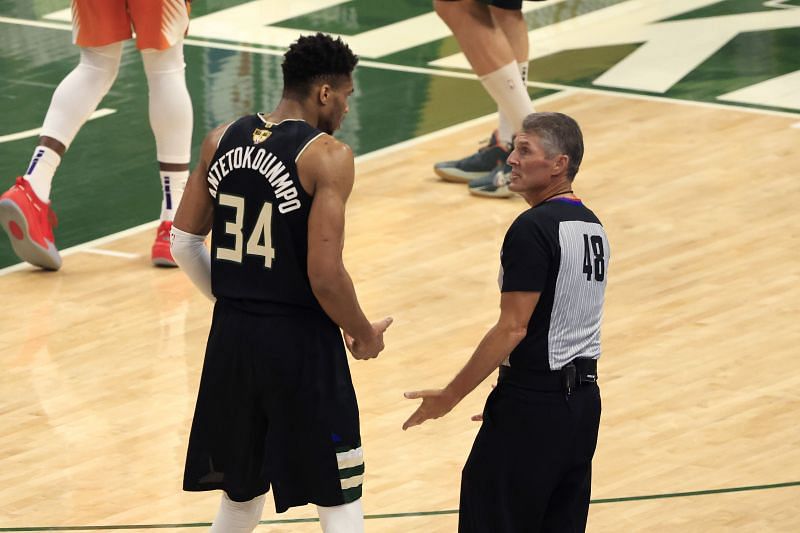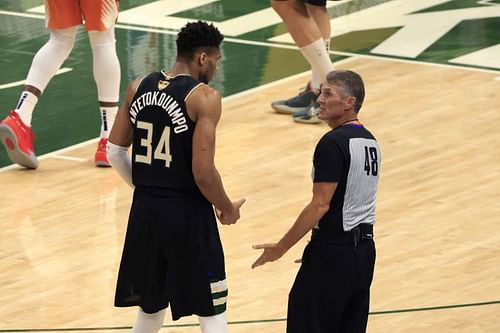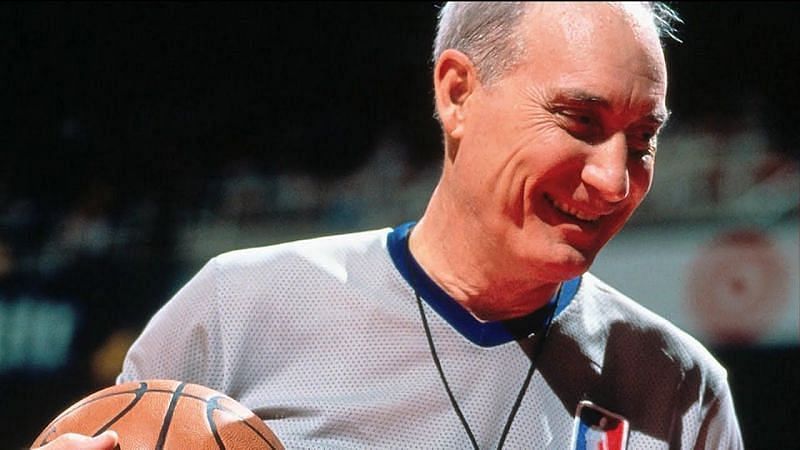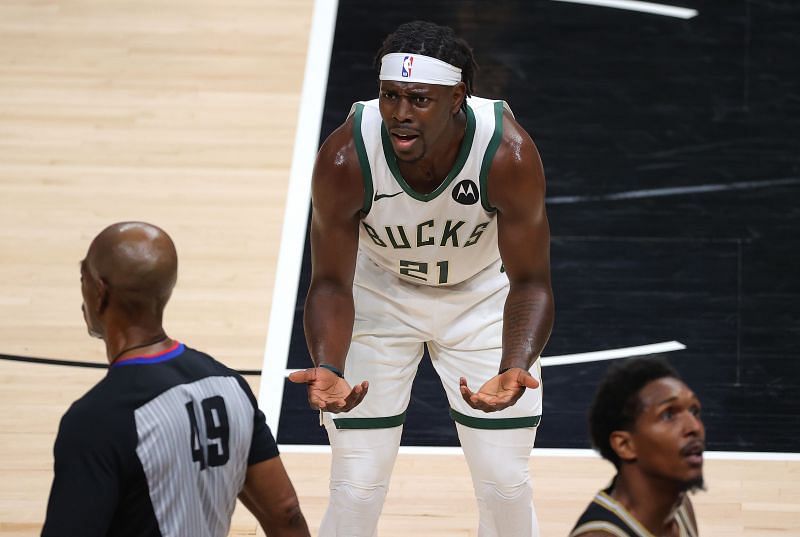
Looking at how NBA officiating and refereeing has changed over the years

The league has gone through massive changes since its inception, with multiple rule changes, changes in refereeing and additions to help speed up the game and make it a more entertaining product for fans. One thing has not changed though: NBA referees are still the biggest scapegoats in the game, with scrutiny falling on them despite them undergoing plenty of changes themselves with the way they officiate the game over the years.
The referees, in consultation with league officials, have brought about key changes in a complex multilayered strategy to improve the accuracy of their decisions such as their positioning, using analytics to rectify certain mistakes and technology to review certain decisions in real time. The advent of the three-point revolution has made their jobs a lot harder as they now had to look for the slightest amount of contact, which is a stark contrast from previous eras with big centers and forwards banging in the post.
The league has tilted towards a more free-flowing offensive playing style which is entertaining to watch but in doing so they have put the cuffs on defenders. Over the years they have curbed or banned things such as hand-checking, which allows defenders to leverage their physicality and put their hand on a player's back to restrict movement of highly-skilled offensive stars. Michael Jordan was a catalyst for these changes, due to the legendary "Jordan Rules" imposed by Detroit Pistons coach Chuck Daly, threatening to almost end the career of the greatest player to ever grace the hardwood.
We have all heard former players and fans criticize the modern game for being "too soft" with fouls being called for the slightest of touches or verbal altercations. The referees have been convenient targets to direct the blame for this decision despite the league's mandate to protect offensive superstars.
To understand the criticism placed on the referees and why it is unfair, you would have to take a closer look at the changes that have taken place over the years which has impacted the way the game has been officiated.
Refereeing changes prior to the 2000's

The league was marred by controversy prior to the Magic Johnson and Larry Bird era in the 80's as they had a drab product on their hands, with fans quickly losing interest due to a slow, uninventive playing style while also having other problems such as drug abuse and racial tensions. The merger with the ABA in 1976 brought along the three-point line, a change that would later revolutionize the league. The legendary rivalry between Bird and Johnson brought the league to the fore as both stars had their own impact which can still be felt today.
However, the league still had a perception of being a "thug's league," partly due to racial profiling but mostly due to extreme physical defense that was borderline violent at some point. Skirmishes were a common sight, with players throwing punches at each other at the slightest notice. Referees turned a blind eye to these incidents as they were unable to stop them from happening owing to no strict rules or suspensions being enforced by the league.
However, things changed after the arrival of Michael Jordan, the league's biggest marketing asset till date, who also happens to be arguably the greatest player of all-time. Jordan's offensive mastery, athletic superiority and high basketball IQ made him virtually unguardable in defense. Teams resorted to a more physical defense to try restricting him, and the Detroit Pistons were at the forefront, led by their legendary coach Chuck Daly.
Daly helped concot the Jordan rules, which are a set of instructions for his team that basically outlined that they were allowed to use their physical dominance to stop him from entering the paint. This meant that Jordan was hacked every time he drove into the lane as either Joe Dumars, Bill Laimbeer or Dennis Rodman met him at the rim. This could have ended very badly for the league as they could have lost their superstar to an injury. The league has since adopted a firm stance on physical defense and things like hand-checking, allowing a more free-flowing offensive style of play that was entertaining to watch.
The league also brought on other key changes, such as permanently increasing the number of referees from two to three, a move spearheaded by legendary referee and Hall of Famer Darell Garettson. They also made changes to the shot-clock rules and increased the three-point line, while also adding a rule to award three free-throws if fouled at the three-point line.
Refereeing changes post the 2000's

The early 2000's saw the changes made in the 90's bare fruit as the league was gearing towards more exciting offenses such as the 'seven seconds or lesser' Phoenix Suns who were pioneers of the three-point revolution that we see today. The change was not immediate, though, as teams like the three-peat Lakers, featuring a dominant Shaquille O'Neal and a young Kobe Bryant, along with others such as the Detroit Pistons and San Antonio Spurs, still preferred to play physical defense while dumping the ball to their big men in the post.
Occasional scuffles were still a common sight albeit not as frequent as before. However, a major brawl in 2004 would change the way the league looked at these scuffles and the way referees handle certain situations forever. 'Malice at the Palace' will always be etched in the minds of fans and players alike due to the severe repercussions that it had.
The league knew it had an image issue after the brawl and came down hard to prevent any untoward incidents on this scale happening in the future. 2004, saw physical defenses that teams were used to being curbed or banned in some cases. Referees were given clear instructions to not allow physical play beyond a certain threshold and toss a player off the court if they were to be involved in any altercation verbal or physical. This curbed defensive players from using their physicality to restrict an offensive star as they were scared to get tossed or suspended due to their actions in the heat of the moment. The league also came down strong on any altercations, issuing suspensions and imposing fines to prevent future occurrences.
This had a domino effect as the newly enforced rules allowed a more free-flowing offensive style while also being a huge factor leading up to the three-point revolution. The ban on hand-checking allowed offensive players to move with more freedom off the ball, helping them find good looks for open shots as defenders struggled to keep up with them. Offensive juggernauts such as the Golden State Warriors are devastating due to their off-ball movement as it becomes extremely difficult for both defenders and the referee to keep track. This brought on changes to the positioning of the referee for them to get a better angle to make the right calls.
2014-15 also brought an important program to help referees enhance their skillsets on and off the court. NBA Vice President of Referee Development and Training Bob Delaney, brought about the Performance Enhancement Program to help referees enhance their skills in the areas of mental conditioning, mechanics, communication and leadership with the help of analytics and other methods.
Offensive players such as Trae Young and James Harden have become more inventive when it comes to drawing fouls, leading to the referee suffering the wrath of fans and opposing defenders alike. However, a rule change this year would ban the use of non-basketball moves to earn fouls, restricting players such as Harden from barreling into the defender to earn fouls.
Conclusion
The inequitable blame placed on referees placed by players and fans alike is something which is extremely unfair more often than not. We get the emotions involved in seeing your favorite team lose due to a single decision not going their way but statistics show that NBA referees get their 93-95 % of their calls right which goes to show that they are more than competent. The massive rule changes over the years and the league's mandate to protect its offensive stars, who are key marketing tools, and their image from untoward incidents such as brawls have put the referees in the spotlight as they have to make decisions that only go along with the rules but also the mandates set by the league.
Throwing a player out for arguing or trash talking looks severe and portrays a bad image of the referee in the eyes of the fan but unfortunately they have to follow the rules set by the league due to previous incidents. The league can absolutely do a better job in making life easier for the refs whether it is to get additional support or tweak certain rules here and there to allow them more freedom to make the right decision. The standard of officiating has not dipped, as many perceive it to be, but will improve with more support.

